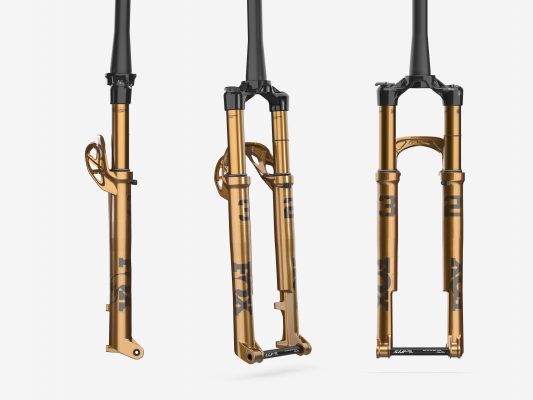Fox's flagship cross-country race fork has a brace designed by A.I. and weighs in at a scant 1,300g.
The new 32 Step-Cast is the lightest fork Fox has ever made. And with the Paris Olympics fast approaching, racers like Fox-sponsored Mathieu van der Poel are looking for every advantage they can get, no matter how seemingly insignificant. The latest 32 Step-Cast takes a radical approach to its design and engineering, to shed around 100g over the previous generation 32 Step-Cast, and come in at under 1,300g (1,296g claimed) while gaining a claimed 40% better torsional sheer stiffness. That compares favourably to the RockShox SID SL at 1,352g, the Cannondale Lefty Ocho Carbon at 1,446g, and the DT Swiss F 232 One at 1,480g. Of course, there will also be a limited edition ‘Podium Gold version with gold lower legs ridden by select pros at the start of the year, then available for the public to buy some time during Summer 2024. UK pricing is £1,119, and in the US, the 32 Factory Step-Cast with Grip SL damper will cost from $969.

That distinctive ‘matrix’ arch on the MY25 Fox 32 Step-Cast was designed with the help of A.I.
It only takes a quick glance to see that the most obvious change with the new fork is the brace position. Instead of being in front of the lower legs, it’s behind, reminiscent of a Manitou fork, or a Pace fork for those with long memories. Why run a rearward brace? Well the simple reason is that it can be made lighter. Since the wheel axle sits in front of the legs, the tyre sits at a lower point relative to the fork’s lower leg assembly at the back than the front, so a rear arch doesn’t need to be as tall to clear it. Less material means less weight for the same stiffness. And as the Manitou patent expired in 2021, Fox (and other brands) is free to use the design.

Cutaway of the MY15 Fox 32 Step-Cast fork showing the new Grip SL damper (right leg), air spring (right leg), rear arch, and bushings.
The arch itself is a unique shape, with a lattice-like web of struts seemingly woven together. And Fox arrived at this organic design via an innovative A.I. solution. After feeding in a set of target metrics for strength and stiffness, along with the expected loads and constraining a 3D envelope within which to work, the special software generates a wire-frame structure to meet the goals. This is then fleshed out with the help of other CAD software. It’s the first time Fox has used this software, so it will be interesting to see if it gets used on other projects, or other brands adopt it for alternative uses.

Intricate casting at the back of the Step-Cast section trims the fat. Rebound damping is adjusted with the use of a long-reach hex key only – eliminating the knob saves weight.
The Fox team has looked everywhere for weight saving opportunities. Obviously the innovative Step-Cast lowers provide the foundation of the fork, where notching out the dropout area allows for a narrower stance while maintaining stiffness. Then there’s the aforementioned brace. But Fox has also chipped away elsewhere, with 8g saved with a new zero-offset crown (the offset is partly in the dropouts and partly by angling the legs out of the crown), 11g saved with a new ultralight steerer, 9g saved with a double-butted upper tube on the damper side, 12g from a new Kabolt axle, and a healthy 60g with the new Grip SL damper.

The new Grip SL damper in the Fox 32 Step-Cast fork uses a coil spring IFP (seen at the top) and a large diameter base valve (the blue section just before the damper steps down) with additional shims to give better damping control.
Available only with 100mm of travel, the new 32 Step-Cast ditches the old Fit4 bladder damper for a brand new Grip SL unit. Like all Grip dampers, this uses a spring to pressurise the IFP (internal floating piston) that maintains consistent damping pressure through the fork as it cycles through its travel. In addition to being 65g lighter than its predecessor, the new damper is said to bring a big improvement in performance. It’s a self-healing damper, so the oil is ingested at the base and recirculated at specific points to keep everything lubricated and running smoothly. Fox has been able to free up space to add shims to the base valve and the mid valve, which helps control a wider range of shaft speeds when racers hit different size bumps.
At the top is a three-position compression dial with an easy-to-reach turnkey style cap and open, medium, and firm ‘virtual’ lockout with blow-off, in case the fork hits a big bump while closed. There’s also a remote lockout option.




